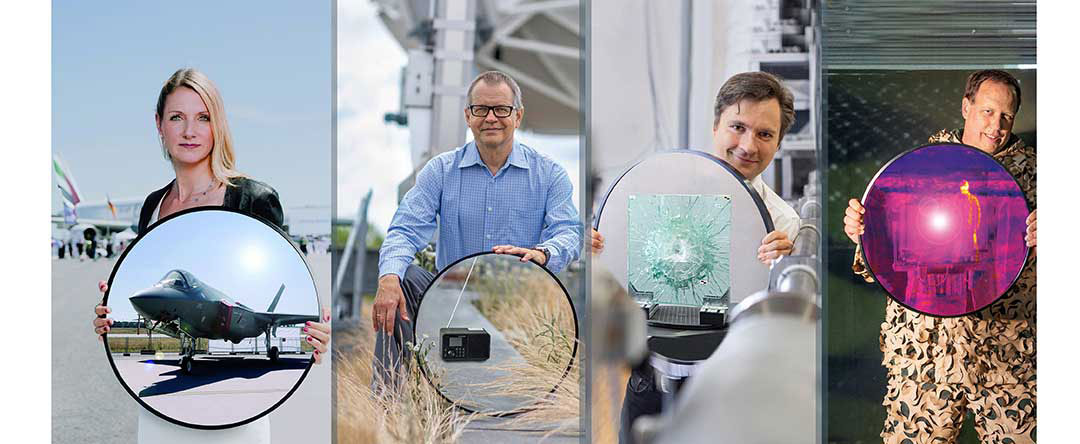Security that reflects the times we live in
Web special Fraunhofer magazine 2.2022
Everyone is talking about the “new era,” that has been triggered by Russian president Vladimir Putin’s war of aggression against Ukraine. In Germany, the response has been for the German Federal Parliament (Bundestag) to approve by a large majority a change to the German Basic Law that will release 100 billion euros in special funding. The war has changed many people’s perspectives of the world, and of Germany’s capacity to optimally deploy its armed forces and offer its citizens the best possible protection in the case of emergency. “We’re seeing a whole host of positive indicators that the government wants to act quickly to strengthen national defense,” notes Prof. Jürgen Beyerer, chair of the Fraunhofer Segment for Defense and Security (abbreviated VVS) and institute director of Fraunhofer IOSB. Caroline Schweitzer, managing director of the segment, also pledges that “The research institutes of the Fraunhofer VVS can substantially contribute to our country’s defense capability.”
VVS is a consortium of eleven Fraunhofer institutes that combine their expertise in research fields relevant to security, military technology and defense. VVS representatives regularly provide their expertise and knowledge to the German Federal Ministry of Defence (BMVg) and its subordinate agencies and to the German armed forces.
Civil protection and defense capability often go hand in hand, as the broad spectrum of technologies that Fraunhofer-Gesellschaft researchers are focusing on developing for the benefit of industry and society also represents areas of interest for the German armed forces. Examples include digital communication technology for emergency and rescue services to use during disasters, and IT security technology for critical infrastructure. These kinds of technologies strengthen the resilience of civil systems and protect people during crises and disasters. At the same time, they help the German armed forces coordinate operations in the best way possible – in collaboration with other European countries, where necessary.
“Europe had already begun collaborating more closely on the issue of defense even before the Ukrainian crisis, and this is now paying off,” says Schweitzer. “The EU drew up the Common Security and Defence Policy (CSDP), which is supported by a range of research programs. Fraunhofer helps shaping these research programs, and we are also actively participating in European consortia that develop new technologies together with partners from industry, research institutions and universities.”
Schweitzer has participated in numerous expert commissions established by NATO. Since 2015, she has been managing director of VVS. She is well aware of the hot topics in the field of defense in Germany at present, as well as the contributions the Fraunhofer-Gesellschaft has made in this area. One assertion by Schweitzer is also frequently expressed by other Fraunhofer researchers: While the war in Ukraine has caused concern, she does not see it as a reason to change course. Her tone is matter-of-fact. “We don’t need to open up new research fields, because we are already well positioned in all areas of technology,” Prof. Beyerer also affirms.
Many examples from the VVS institutes show how Fraunhofer research has contributed to maintaining Germany’s defense capability.
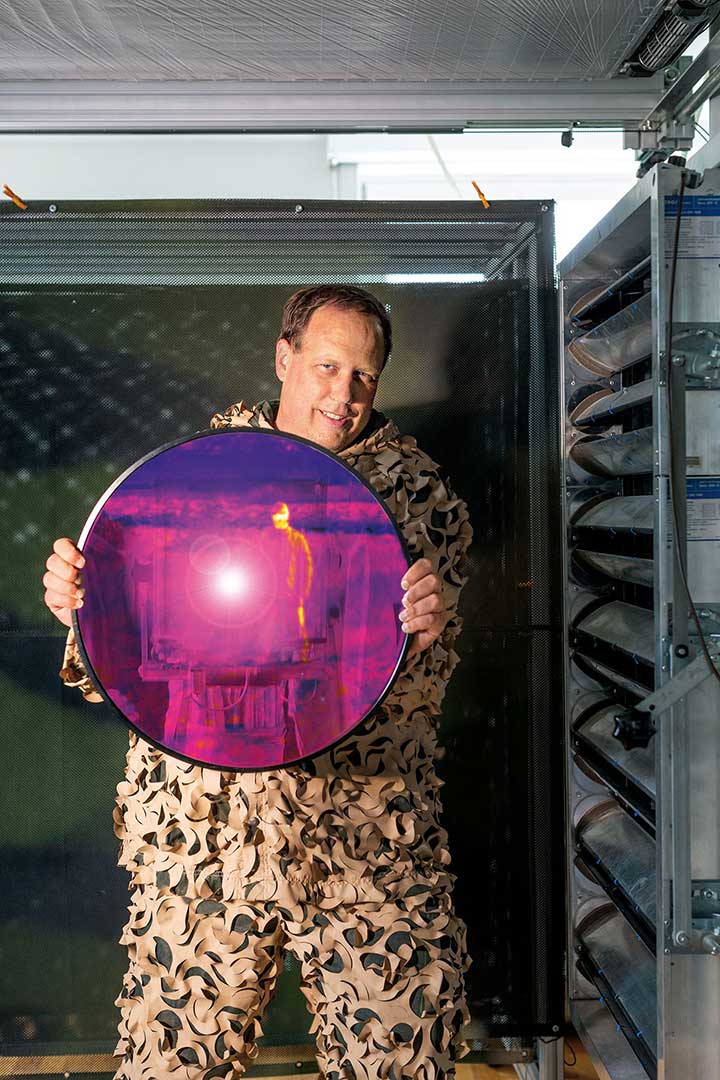
“Enhancing protection for our soldiers”
Defense means self-protection. Camouflaging vehicles and uniforms is a centuries-old practice – one that researchers at the Fraunhofer Institute of Optronics, System Technologies and Image Exploitation IOSB are currently aiming to improve upon. They are working on camouflage clothing that autonomously adapts to its environment. Integrated sensors measure the ambient brightness and predominant colors and then transmit this information to intelligently controlled LEDs integrated into the textiles. These then emit light in the appropriate color and level of brightness, al lowing soldiers to essentially merge with their surroundings. The person wearing the uniform does not need to do anything – they do not have to press a button or activate any sensors. This technology is already here. In the future, if a soldier is in contact with aerial reconnaissance via an information system, the camouf lage clothing will be able to adjust its color spectrum in order to avoid being detected by the optical sensors of an overhead drone. “We can use camouflage to manipulate perception,” explains Max Winkelmann, research fellow at Fraunhofer IOSB. The team is not only focused on optics, however – the researchers are also conducting research into textiles that can deceive thermal imaging cameras. “We are currently experimenting with a broad range of new technologies to enhance protection for our soldiers,” reveals Winkelmann.
Laminated safety glass provides security
The Fraunhofer Institute for High-Speed Dynamics, Ernst-Mach-Institut, EMI is also focused on optimized protection for people in deployment. Here, Elmar Straßburger and Dr. Steffen Bauer shoot at glass with metal projectiles, evaluate the damage and draw conclusions about how windows in vehicles can be better protected when under fire.
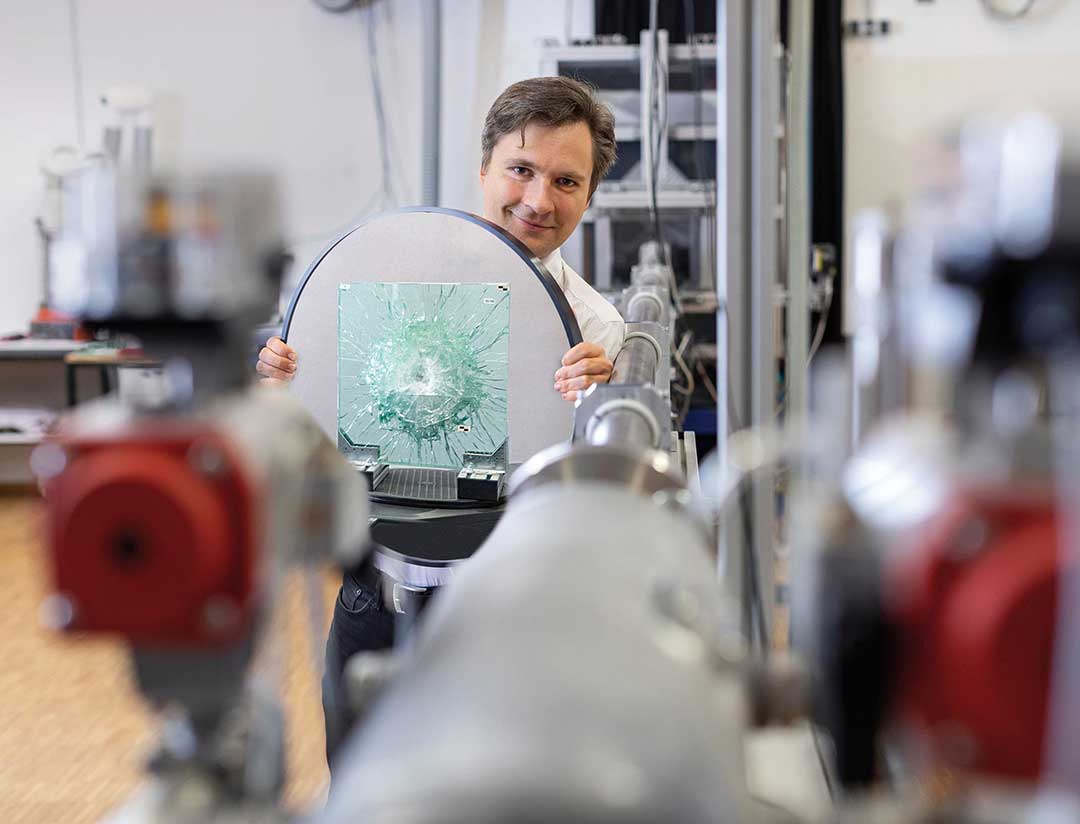
Laminated safety glass is generally used for this purpose. Ultimately, its strength is determined by the thickness of the individual layers and the combination of different glass types used. “We are not simply investigating whether the projectile breaks through the pane. The pane often withstands the first shot, and the second one, too. But with the third shot, the pane shatters completely and can no longer protect people inside the vehicle.” The researchers are therefore focusing on the question of how stable a pane of glass is when it has already been damaged by a projectile – and the initial damage happens right at the moment the projectile strikes, i.e. before it begins to penetrate the glass. This is because the impact creates shock waves within the glass that precede the projectile at high speed and can lead to cracks forming. Fraunhofer EMI researchers are using high-speed cameras to record these processes – from the impact to the deceleration of the projectile in just 200 microseconds. The experts are also using X-ray computed tomography and numerical simulation models “in order to make more precise predictions regarding the strength and resilience of laminated glass and laminates with different material combinations and layer thicknesses,” explains Bauer.
Air defense system "Future Combat Air System"(FCAS)
Fraunhofer researchers are also involved in what is expected to be the largest and most ambitious European defense program of the coming decades. There are plans to integrate the Future Combat Air System (abbreviated FCAS) as an air defense system into existing platforms such as Eurofighter or Rafale from 2040 onwards, before fully replacing them at a later point. Almost all VVS institutes are participating in this mammoth project, with Fraunhofer FKIE acting as the point of contact. FCAS will be much more than just a combat aircraft. The latest generation of manned jets will be integrated into a “system of systems.” Unmanned aircraft, known as “remote carriers,” will accompany and protect pilots during combat missions. Central to this will be the Air Combat Cloud that will provide those involved with all relevant information in real time.
This new solution raises new questions. Advanced technology and digitalization are increasingly accelerating military operations and making them more data-intensive, which in turn means they are more complex. However, when AI-driven systems start making decisions by themselves, the technology is crossing a line. “The requirements for speed and complexity in future combat situations will be so high, they will not be possible without semi-automatic or automatic technical processes,” explains Prof. Wolfgang Koch, chief scientist at the Fraunhofer Institute for Communication, Information Processing and Ergonomics FKIE.
This will require new evaluations and analysis of the use of artificial intelligence (AI) in weapon systems. VVS has drawn up a position paper, “Rise of Intelligent Systems in Military Weapon Systems,” for this purpose. This sets out the latest technological advancements, investigates uses and risks, and presents a conceptual framework for explainable, controllable AI.
But that’s not all. Researchers have established the Working Group on Technology Responsibility, which aims to define and present ethical and legal guidelines for Europe’s largest defense project. In addition to Prof. Koch, participants in the working group include individuals from different social groups, such as the writer Nora Bossong, Anja Dahlmann of the German Institute for International and Security Affairs, Ulrike Franke, senior policy fellow at the European Council on Foreign Relations (ECFR), and the historian Florian Keisinger. “The working group is not intended to be a toothless debating society, and is most certainly not an intellectual fig leaf to conceal the use of AI in military operations,” affirms Prof. Koch. “The plan is rather to provide systematic support and help shape the system design, operation and implementation of technologies in FCAS.”
Germany, Spain and France have teamed up to develop FCAS, with additional European countries set to join their ranks over time. “FCAS is a pan-European project that could greatly boost the European Common Security and Defence Policy,” explains Koch.
Precision creates security
Precise knowledge also helps improve safety for emergency service personnel. Researchers such as Dr. Stephan Palm at Fraunhofer FHR in Wachtberg are focused on reconnaissance, more specifically synthetic-aperture radar (SAR). This form of radar generates an image from many smaller images captured with a moving antenna, showing the two-dimensional reflectivity of the scene. Scientists at Fraunhofer FHR are experimenting with circular SAR at extremely high carrier frequencies. Dr. Palm has also completed a PhD on the topic.
Research must focus on public safety and security
During this process, an aircraft or reconnaissance drone follows a circular flight path around the area to be observed while continuously directing a radar beam at the center. This generates images from multiple angles, enabling individual objects to be captured in 3D, i.e. viewed from several sides. This also allows for a much higher resolution can be achieved with conventional imaging on linear trajectories. “Circular SAR makes it possible to create SAR videos and visualize objects in motion on the ground, such as moving cars,” says Dr. Palm.
Using the current experimental system, a reconnaissance aircraft flying at a height of 600 meters over the target area can identify objects smaller than 5 centimeters in size. Aircraft can also reach much higher altitudes if more output power is provided. This allows for high-resolution reconnaissance in real time, even in poor weather conditions or at night.
An additional focus of research activity at Fraunhofer is public safety and security. Daniel Hiller, managing director at Fraunhofer SIRIOS, describes enormous “challenges for society posed by dangers such as terrorism, cyberattacks and climate change.” Fraunhofer SIRIOS, a collaboration between four Fraunhofer institutes, commenced operations in January 2022 in Berlin. These Fraunhofer experts are focusing on the principle of simulations that can be experienced virtually. Fraunhofer SIRIOS creates detailed simulations of the development of dangerous events such as attacks or explosions, and the probable reaction of the people affected. However, the simulation is not only limited to abstract data sets and graphics. “Our aim is to create a virtual visual representation of these events and their specific effects, including using 3D VR.”
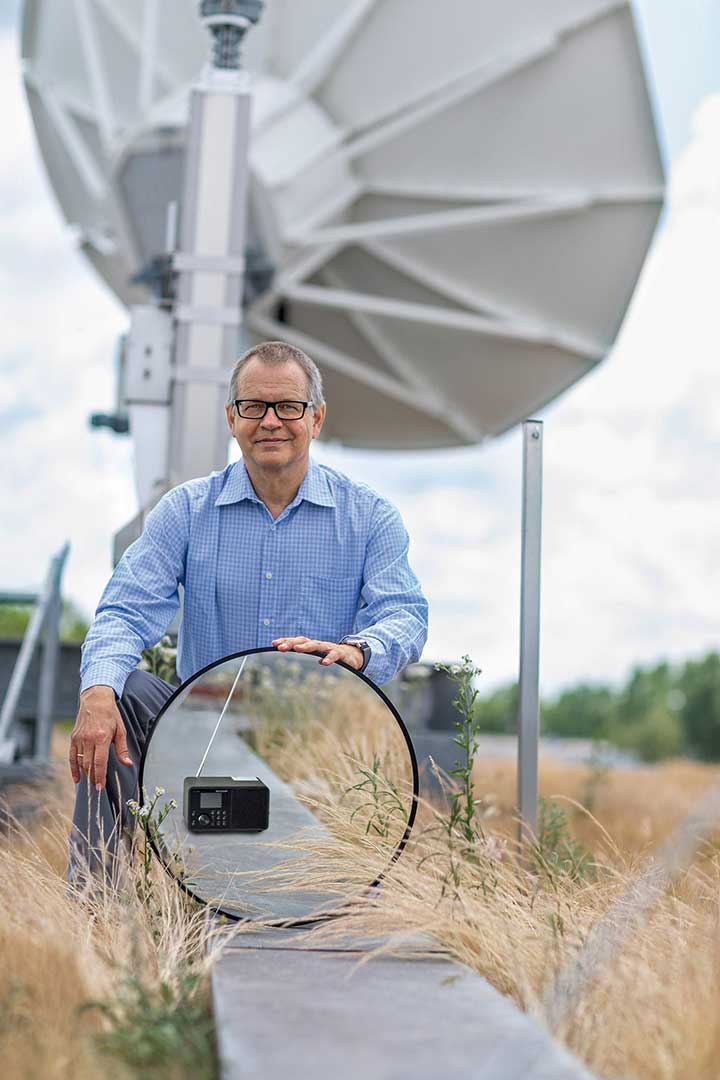
How can warnings be issued to the public?>
Olaf Korte at Fraunhofer IIS is focusing on early warning systems, which are crucial in hazardous situations such as natural disasters. Many traditional warning siren systems have been dismantled in recent years, or are no longer being maintained. Although warning apps do exist for smartphones, these devices rely on a functioning cell phone network. Radio networks are much more robust. Olaf Korte and his colleagues are betting on these. The EWF (Emergency Warning Functionality) feature allows for a warning to be triggered from a central location such as an interior ministry. This is sent as a switchover or wake-up signal, and transmits an audio message with scrolling text to the display on the end device. DAB+ radios can receive the message. Higher-quality receivers also offer multilingual and more detailed text for hearing impaired people and foreign language speakers. The warnings and information text can also be used for public display boards. “An advantage of this technology is that warnings about an imminent storm, for instance, can be regionally distributed in a highly precise way,” says Korte. The distribution of DAB+ in Germany is currently only around 25 percent, but this figure is increasing.
A radar for investment
Globally, research and technological development in the areas of civil protection and defense has been running at peak levels in order to better protect people not only from the impact of climate change, but also from military attacks. The military technology radar (MiTeRa) tool developed at Fraunhofer FKIE delivers a continuously updated overview of a wide range of research activities.
Dr. Hanna Geppert and Dr. Carsten Winkelholz have created this software tool together with their team and the German Federal Ministry of Defence (BMVg) to maintain a continuous overview of the maturity level, intensity and planning status of research activities related to important future technologies. “When certain communication tools become obsolete, it’s important to know when new technology will be market-ready, in order to avoid gaps,” explains Dr. Geppert. This is made possible by taking an ergonomic approach, and by considering who requires information to make an informed decision, what kind of information they need, and when they need it. The result is an interactive, intuitive representation based on visual analytics. The BMVg is currently using the technology radar tool in cybersecurity and IT research, and there are plans to use it in additional areas as needed.
A growing need − and government willingness put down on paper
The German armed forces and Ministry of Defense also want to know about future technological trends and what the armed forces’ equipment will look like in the future. The technology that will be employed in modern weapon systems in 10 or 20 years is the subject of ongoing research projects − mostly driven by civilians − in laboratories around the world, although technology readiness levels are still low. The Fraunhofer Institute for Technological Trend Analysis INT offers an overview of this research. “We have been providing a 360° view of this complex technological landscape for over 40 years, and we advise the BMVg in terms of designing their departmental research program,” explains Prof. Michael Lauster, head of Fraunhofer INT and deputy spokesperson of the Fraunhofer Segment for Defense and Security VVS. In addition, the quarterly publication from Fraunhofer INT, “Defense Technology Foresight,” provides planners and decision-makers with essential information for making future-proof equipment decisions.
Germany’s defense requirements are growing, the government’s willingness to act is a documented fact − and research is ready and waiting. “We have already made targeted offers of services to the Ministry of Defense,” says Schweitzer, VVS managing director. “We are in a position where we can rapidly react to specific requests from the German armed forces and bring new technologies into the field,” Prof. Jürgen Beyerer, VVS chair, also affirms. When it comes to the current situation, the VVS chair believes that: “We will be able to demonstrate this capability to an even greater extent in the future.”
7 hypotheses on the future of defense technology
By Prof. Michael Lauster
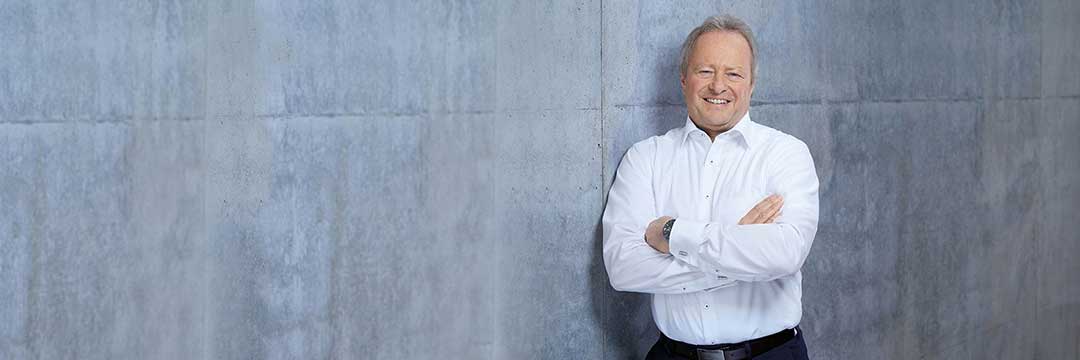
1
Specially adapted materials are crucial to armed conflict in all domains, whether land, air or sea. Just like knights’ armor hundreds of years ago, modern battle tanks are becoming heavier, and therefore less and less mobile. Robust, light materials and new protection methods are enabling the construction of smaller, lighter vehicles that offer their crews the same level of protection. They are also more mobile and require less energy for operation. Especially when considering the shortage of fossil fuels, weight is an essential factor.
2
In addition to new drive and control concepts, materials that are light but also resistant to high temperatures are crucial for the push into the area of hypersonics. Hypersonic aircraft deliver a new level of quality. They are difficult to track, can be maneuvered even at the highest speeds above Mach 5, i.e. over 6,000 kilometers per hour, and achieve ranges of several thousand kilometers. For high-value targets, they represent a threat against which there is currently little defense. To safeguard such targets, the development of new camouflage materials is growing in significance, in particular for ship and submarine protection.
3
Quantum technology (see p. 24 for “On your marks … get set … compute!” and p. 47 “When quantum computers attack”) represents a promising area for disruptive development, and not only in the civil division. Quantum computers could play an important role in material design in the future. Their development is just one aspect of the practical application of quantum theory, which will also open up the field of subatomics for military use. Quantum communication, quantum sensors and, last but not least, weapons based on quantum effects, such as lasers with an output of over 100 kW, are all currently in development.
4
Machine learning and pattern recognition offer valuable support for evaluating sensor data or detecting adversarial behavior. For military use, the most important factors are understandable decision-making processes (explainable AI), interference resistance in the military’s own AI system and the potential to deceive another AI system (adversarial AI). Digital imaging of a battlefield will be available for all levels of organization, and the required information will be transmitted according to the situation.
5
Space travel is set to play an increasingly significant role in security. Satellites will be used for navigation and communication, but that’s not all. In the future, it will be possible to carry out reconnaissance using satellites in low Earth orbit, with customizable configurations that can be launched as required. Under the “responsive space” model, it will be possible to quickly replace disabled satellites in orbit by launching our own assets within a short time.
6
Technology has been a decisive factor in armed conflict throughout history. The side that could build more effective weaponry had a significant advantage. Swords and shields made from bronze were tougher and more durable than their precursors made of copper or wood and animal hide. The development of powerful crossbows and the first muzzle-loading firearms brought the era of heavily armored knights to an end; the invention of aircraft unlocked the aerial domain as an additional battlefield. When combined with ships from which they could launch and land, aircraft enabled global power projection. A range of nuclear weapons, alongside carrier rockets and other long-range forms of transportation led to the rise of superpowers. Still today, armies aim to use the highest-quality equipment. However, even the most up-to-date technology is useless without people who know how to use it. The difference between combat effectiveness (i.e. the type and number of weapons) and combat readiness (i.e. the determination and ability to deploy them) is crucial. Only a combination of effective technology and highly motivated, well-educated soldiers will lead to success in combat situations.
7
For all the latest technology, it is the 2,500-year-old saying from Sun Tzu’s “The Art of War”, the earliest historical text on strategy, that holds sway: “To fight and conquer in all your battles is not supreme excellence; supreme excellence consists in breaking the enemy’s resistance without fighting.”
